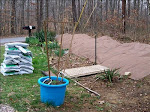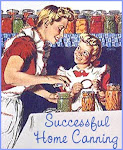
That's an Eastern Tiger Swallowtail...female...which have lots of blue on the hind wings. Some are black, but the yellow is more common. Only the females come in both yellow and black forms...the black is similar to, but bigger than the Black Swallowtail. Eastern Tiger Swallowtail caterpillars are dark green with two large eyespots. They eat various trees and shrubs especially Yellow Poplar, Wild Cherry, and Sweet Bay.


Herbs
I spent the past two weeks studying and being tutored about herbs and herbal remedies. During this time I carefully made oils, vinegars and tinctures.
Here’s how I made the tinctures: I used dried herbs (flowers or roots according to use). I put about two cups of herb into a quart jar. Then I poured just enough very hot water (not boiling) on the herbs, just enough to soak them. Then I added different 80-proof alcohols, depending on what I already had on hand. So I ended up with tasty-sounding tinctures. These tinctures have to be shaken twice daily.
English plantain in Rum
Red Clover in vodka
Gingko Leaf in citron vodka
Cinnamon sticks in bourbon
Siberian Ginseng root in bourbon
Siberian Ginseng root in vodka
Infusion Oils:
Lavender
I filled a small jar with dried lavender flowers and covered the flowers with sunflower oil. After removing the bubbles I floated two tablespoons of vodka on top. The alcohol helps to keep the oil from getting rancid and also aids in extracting the oils from the herbs. I covered the jar of oil with thick cheesecloth so the alcohol could escape and placed the jar in a sunny window. I check the jar every day for signs of spoilage then gently shake it.
Supplies: Small mortar and pestle, alcohol (vodka), bottles and jars, oils, beeswax for salves. I’m using different base oils according to how I’ll use the oil later on. Some oils are absorbed into the skin and some are not.
I spent the past two weeks studying and being tutored about herbs and herbal remedies. During this time I carefully made oils, vinegars and tinctures.
Here’s how I made the tinctures: I used dried herbs (flowers or roots according to use). I put about two cups of herb into a quart jar. Then I poured just enough very hot water (not boiling) on the herbs, just enough to soak them. Then I added different 80-proof alcohols, depending on what I already had on hand. So I ended up with tasty-sounding tinctures. These tinctures have to be shaken twice daily.
English plantain in Rum
Red Clover in vodka
Gingko Leaf in citron vodka
Cinnamon sticks in bourbon
Siberian Ginseng root in bourbon
Siberian Ginseng root in vodka
Infusion Oils:
Lavender
I filled a small jar with dried lavender flowers and covered the flowers with sunflower oil. After removing the bubbles I floated two tablespoons of vodka on top. The alcohol helps to keep the oil from getting rancid and also aids in extracting the oils from the herbs. I covered the jar of oil with thick cheesecloth so the alcohol could escape and placed the jar in a sunny window. I check the jar every day for signs of spoilage then gently shake it.
Supplies: Small mortar and pestle, alcohol (vodka), bottles and jars, oils, beeswax for salves. I’m using different base oils according to how I’ll use the oil later on. Some oils are absorbed into the skin and some are not.



































